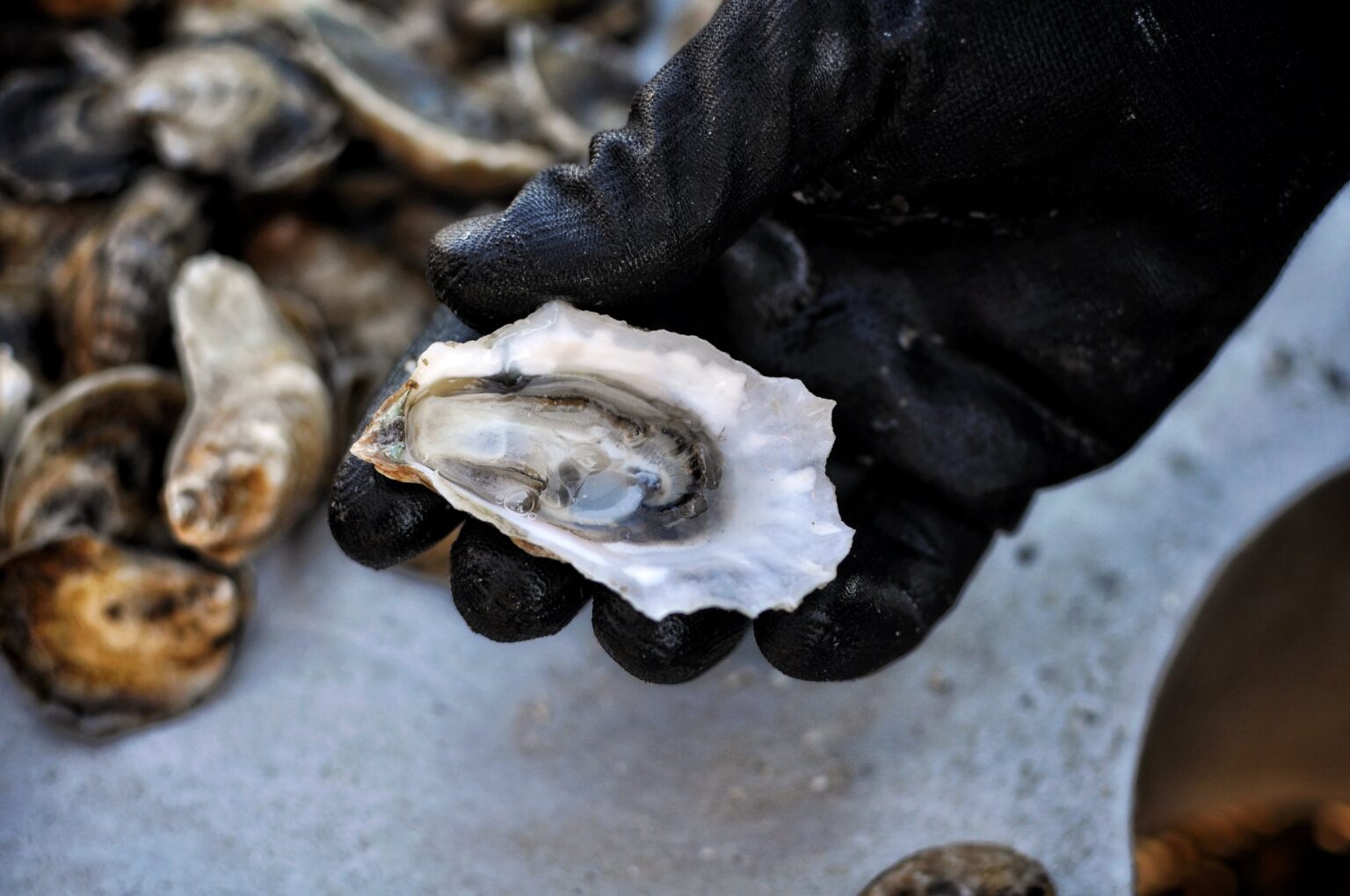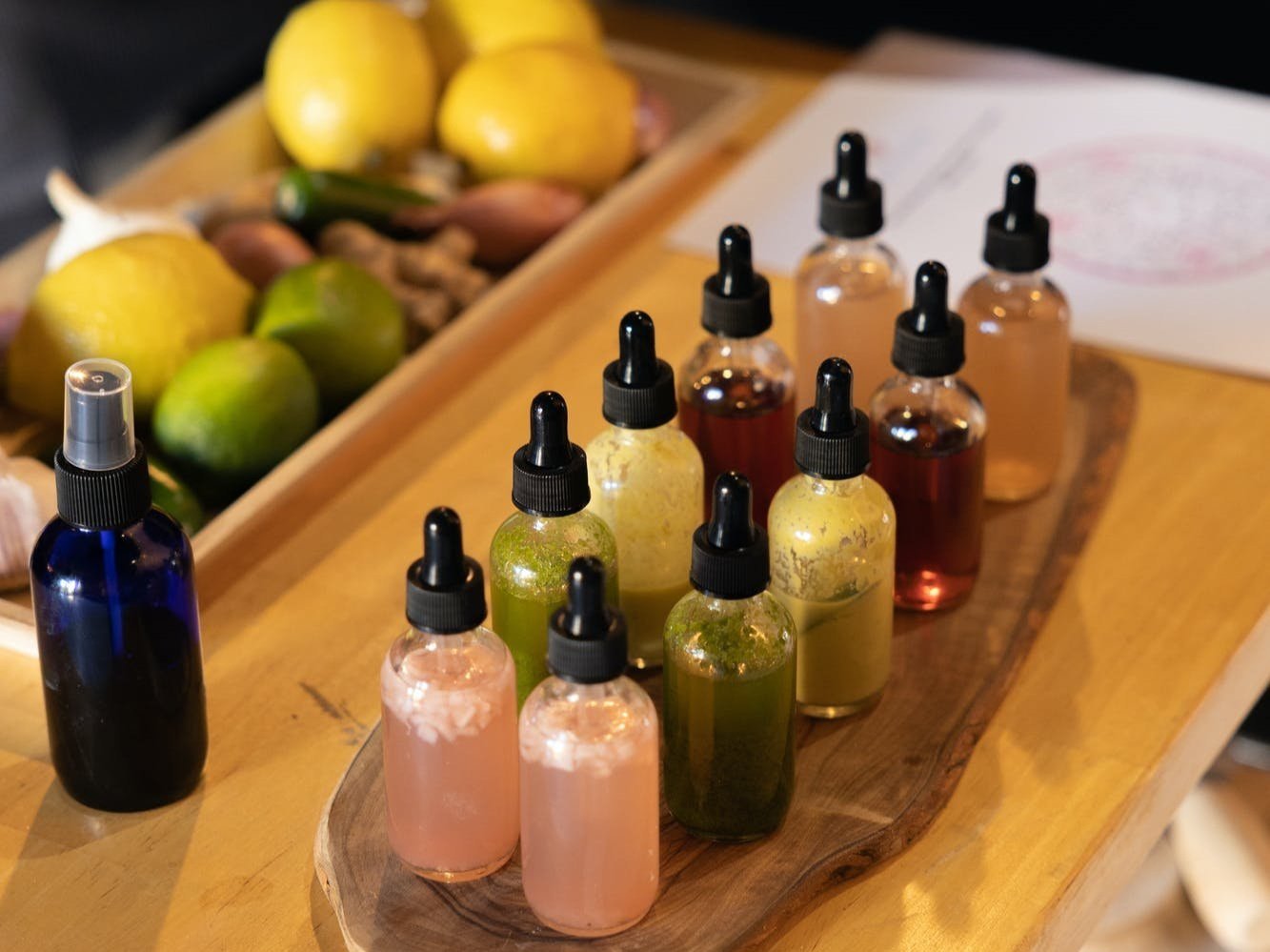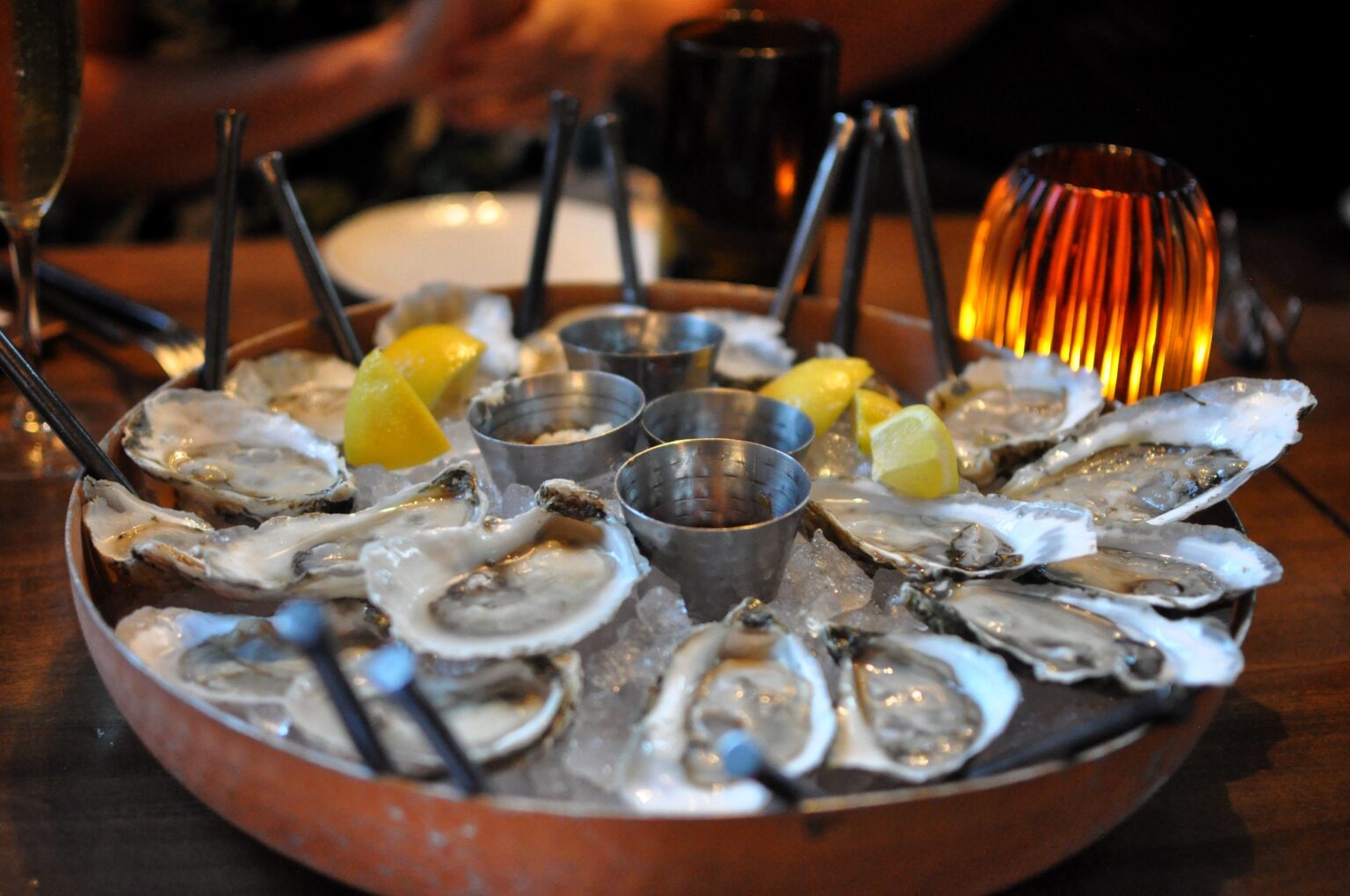Florida’s Oyster Bay | A Neighborhood on the Water

Like a pair of dark-eyed juncos in winter, Warwick and I flocked south this January, looking for some reprieve from Vermont’s snow squalls and frozen nostrils, falling icicles and frostbitten toes. Brisk, bright, and dry is how I might describe Florida in the height of winter. Crunchy brush, and no melting banks sludging down the driveway. But unlike up north, the Panhandle’s coastline still called us with an inviting tone; a far cry from the piercing chill lifting off a Maine or Massachusetts shore.
The wind gripped my face as we skid along Oyster Bay’s shining surface, just east of Panacea. At last, I thought, a breeze that carried the sun with it! At the helm of the skiff were Teresa and Joseph Mercer, whom I had crossed paths with before at a few oyster festivals, but only in slurps and salutes. When it came time for a proper introduction, Warwick and I thumped aboard TAB’s boat, shook hands, and looked towards the Bay as if we all knew what to do.
TAB Oysters is a husband-and-wife team, but a true family affair. Joseph and Teresa have been farming since 2016 after a handful of oyster leases became available in Wakulla County. Teresa grew up on a farm, and Joseph had a background in commercial fishing, so farming oysters seemed like a natural fit. “TAB” Oysters were named after the initials of their three daughters, Taylor, Ava, and Brooklyn, now ages 16, 11, and 6. Once schools’ out, they “help” with the farm, but mostly enjoy kayaking around the lease, fishing for what’s lurking underneath the cages, and slurping.
As we pulled out of the harbor, Teresa began to tell me about her girls. “My youngest is so funny. We used to stop at the gas station in the mornings to get her something to drink and occasionally a Hershey bar. She loves sitting out on the farm, eating oysters and chocolate. That’s her favorite breakfast.” I grinned, imaging a super-human level of endorphins bolting through a first grader.
The tide at 10AM was just a lick of surface tension above the flats. Joseph, an expert boatman, weaved us through the Bay’s labyrinth of shoals, oyster lines, and marshes at lightning speed. I found myself squeezing my insides for buoyancy and praying we wouldn’t thud into sand, limbs flailing and bodies airborne.
As we neared TAB’s lease, the water was far too thin for the boat to reach their cages, but we found a friendly face along the way to pass the time. Adjacent to Joseph and Teresa’s oyster lease stood a man named Larry, who was strolling along his own line of bags, swinging in the wind above the mud.
Larry Bowen is Joseph and Teresa’s oyster farm neighbor, but also an old friend. He used to commercially fish with Joseph prior to their journey into aquaculture.
“Believe me, I like oysters,” said Larry. “But there’s still nothing like fishing,” with a sly grin.
Officially “retired,” Larry is out on the water often, putting in the manual work to cultivate his oysters. After hand-shaking a few of his bags, he turned towards us and waved us over for a stop-in, grabbing the end of Joseph’s boat and sinking his boots into half a foot of mud.
After catching up, Joseph convinced Larry to bring over a bag of oyster seed so we could take a look. Larry unhooked a bag and dumped them across on Joseph’s culling table on the skiff. We ran our hands though the feathery dime-sized shells, enjoying their scratchy textures and discussing their potential.
“I shake the cages once they get a little older to develop a nice cup on them, or else they’ll grow flat,” Larry insisted. I began to comment on the remarkable nature of how so many young oysters could fit in a single bag at you could carry: about 25,000.
Larry poked through his shells, occasionally grabbing a few to show us which ones he thought were going to make it and which ones weren’t based on their sizes and shapes. The oysters glittered in the sun of rich amber hues as we began to funnel them back into the bag and bid Larry farewell. The water had gained about an inch or two on us, and Joseph reckoned he could make it to their own cages.
Joseph puttered around Larry’s lines and had a clear line of sight to their lease. He told us to grab on to something. I closed my eyes and squeezed the skiff’s rim as the boat gunned forward. We waterskied for about 100 yards in what felt like a sheet of glass between us and the mud. The boat sighed along with the rest of us when we came to a stop next to TAB cages. Larry motioned a nod of approval from afar.
“When we first started farming oysters, we got stuck out here once,” Joseph recalled. “ We waited three hours for the tide to come back, freezing on top of the mud!” I found out later that this was a big deal for a guy like Joseph. He was a well-known Master of the Waters on a boat. Getting stuck in the mud at low tide could happen to anyone, but even Joseph? Oystering was a risky business.
As we waded by the cages, I noticed that each lease had slightly different techniques applied, despite being so close together. Teresa chimed in. “Everyone out here likes to do their own thing. Larry likes the Seapa lines, but we like the floating cages. The cages are ideal because you don’t have to get out of the boat!”
TAB Oysters are called “Piney Island Selects,” and the name pays homage to Piney Island, a neighboring land mass strewn with squiggly, tentacle-like inlets and lagoons. The shoreline drips in a sepia-toned salt marsh in winter, followed inland by Cypress, Long-leaf pine, and Palm trees. Tiny clusters of oysters the size of cantaloupes and baseballs cluttered the brim of sand before the Hardy Grass. These small colonies were exposed at low tide and showed hope for wild populations.
Piney Island provides a protective, private vista from the oyster farms in the Bay, feeding its flavors down into the waters and across to hungry oysters. Teresa admitted that despite winter’s colder temperatures, their oysters had still experienced a strong winter growth spirt. Joseph poured out a bag of Piney Island Selects that were close to market size. Their deeply cupped shells were supported by pointy phalanges that flared from the center, nearly taking on the same piney characteristics as their surroundings. Joseph grabbed a knife and began to shuck a few for me and Warwick. We awed at their plump bodies and fresh curly mantles before the slurp. The adductors were so sweet, harboring a finale of flavor and earthy richness.
Teresa held up a small, two-inch oyster at best. “Our six-year-old likes them about this size. This makes her happy.” It seemed proportionate for a youngster, and a decent sea salt garnish to a large chocolate bar. Joseph went on to explain that it only takes about a year to grow an oyster to market size in the area, but if you grow them past a year and a half, they have a higher risk of attrition. After Hurricane Michael, farmed oysters have been experiencing mortality after a certain age. It’s concerning for oyster populations, but luckily and for most farms, it’s a term that’s not often reached before harvest.
Teresa shared more about oyster processing with me and how many of the farms there go to market. Processers support the oyster supply chain once they’re ready for harvest. A processer in the state of Florida is someone who can clean the oysters with specific machinery, tag, and store the oysters before they’re shipped to restaurants and wholesalers. TAB sells to a small handful of processers, one being Oyster Mom, owned by Deborah Keller and a neighboring farm in Oyster Bay.
Working with a processer comes at a cost— up to a dime an oyster, which adds up. However, it’s a trade-off many are willing to make. The machinery is expensive and regulations are strict, so partnering with a processer eases the level of investment that oyster farmers need to enter the business. For Joseph and Teresa, oyster farming is another income stream to Joseph’s full-time occupation as an Electrician, and it gives their family the flexibility to be there for their girls . From volleyball, to school, to summer activities, oyster farming is part of the family dynamic.
“Our oldest one hit her growth spirt in high school. She was so little playing volleyball, but the hardest worker,” said Teresa.
“Taylor, our middle is an incredible volleyball player, “ added Joseph. “She’s so strong.” He paused before continuing. “But she’s got an attitude. That girl won’t work for anyone.”
We all laughed, perhaps remembering our own pre-teen irreverence.
“We level them out,” said Teresa. “In the summer we’ll come down and flip cages together and dry them out. We try and put them to work!”
As we continued to chat about working on the water, Teresa explained life in January. “This time of year is big on hunting season. It ends on Wednesday and after that we’ll be out here more often.
“You don’t mess with hunting season,” she insisted and Joseph agreed. “All of our children were planned around it. Weddings are planned around hunting season… unless they really don’t want us to show up!”
I went on to explain that we knew the feeling up north. Our plans for a housewarming in Vermont were also interrupted by hunting season. After November 6th, we didn’t even bother. I felt at ease with Teresa and Joseph, like kindred spirits across Northern mountains and the Southern coast.
As we began to return the oysters to their cages, Joseph floored it once again across the sky’s reflection and back to deeper waters. We twisted and turned through the other leases nearby. It began to hit me just how special the area really was. From one patch of cages to the next, there was a full collection of farm names I recognized, and farmers I’ve met before in other places. Oyster Mom, Pelican Oysters, Cypress Point, Shiny Dimes… It all felt different once I could visit their world to see where their oysters waded. This was a neighborhood on the water. Retirees could find a way to stay connected to the outdoors, families could earn an income and spend time with their children. Others could be there full-time. I knew it was hard work, but it also felt freeing. Aquaculture may be a young vocation in Florida, but it’s creating a culture of its own.
I felt the breeze along my face one last time before entering the serene strip of harbor back to the car. Handshakes turned into hugs as we disembarked and continued on to our next visit. With every farm visit, there’s plenty I learn and appreciate about oysters. But what I connect with the most are the little moments in between, like skidding across water, laughing about kids, and stopping by to visit a neighbor. There is something to be said about stepping into a lifestyle on the water, sitting with it, and enjoying the ride.
Many thanks to Teresa and Joseph Mercer for having us out on the boat this winter! You can check out TAB Oysters at https://www.facebook.com/taboysters/ and follow them on Instagram at @taboysters.















